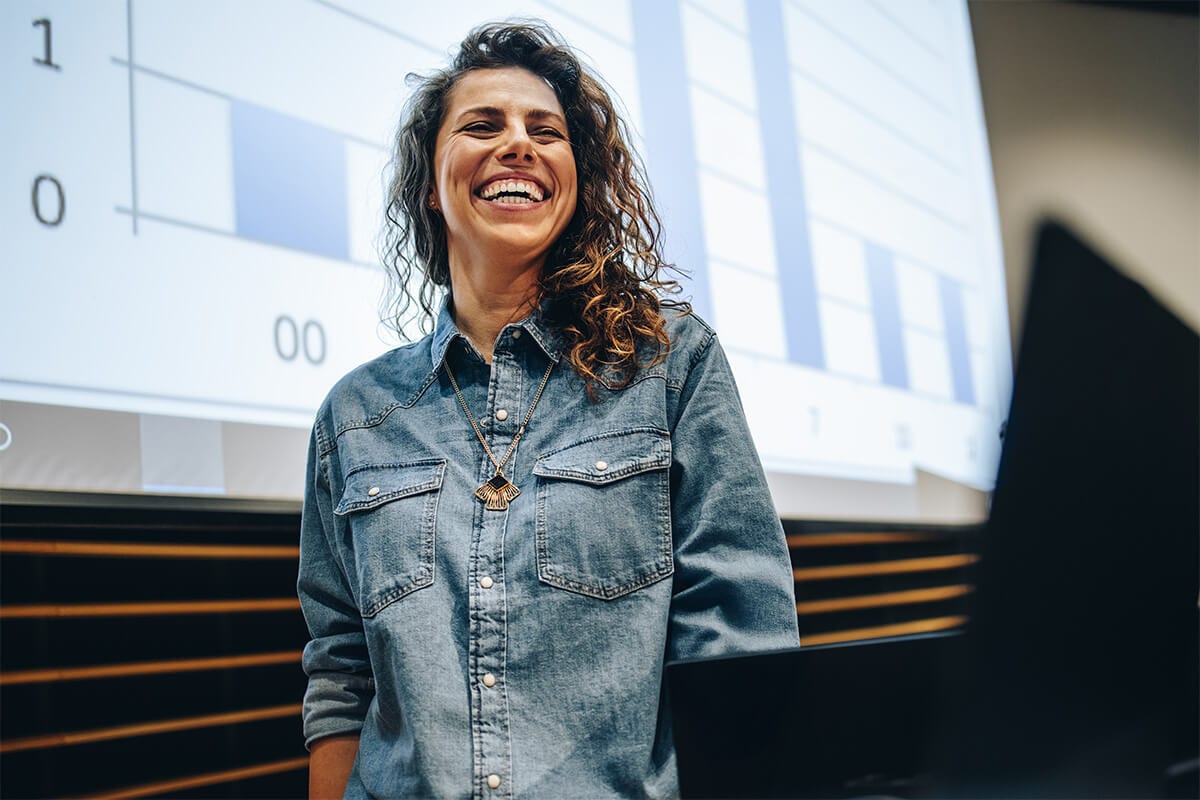Explore the evolving role of AI in higher ed. Join our panel discussion on thoughtful AI use and practical strategies for using it effectively in the classroom.

Trusted
With reliable Pearson content at its core, it ensures accuracy, protects privacy, and keeps learning on track every step of the way.

Tailored
Purpose-built for education, our tools are aligned to your course, personalized for every learner, and at the right level of challenge, always.

Built-in
Integrated into the tools you trust, saving time while driving better outcomes and paired with tools to help students use AI responsibly.
With AI-powered study tools, students receive:
Instant support: on-demand summaries & step-by-step explanations
Personalized practice: targeted support right where students are learning
Course-aligned: supports your curriculum and teaching using trusted, Pearson-authored content
Always on: reduces frustration, boosts student performance
Smart, seamless, and built for learning
Discover the power of an interconnected learning experience with the AI-powered study tool in MyLab, Mastering, and Pearson+.

MyLab & Mastering
AI breaks down complex problems into manageable steps, turning homework challenges into learning moments.

eTextbooks, available in Pearson+
AI provides on-demand, personalized support as students engage with their assigned materials.

Study Prep, available in Pearson+
Give students the study help they need with bite-sized videos, practice problems and 24/7 AI-powered support that’s tailored to your course.
AI study tool in action
. . . . . . . . . . . . . . . . . .

Are your students prepared to use AI responsibly?
Simple to add. Powerful to deliver. Equip your students with essential AI skills, without adding to your workload. Available in 170+ MyLab, Mastering, & Revel courses, AI Literacy Modules will teach your students how to use AI tools, validate results, and cite AI ethically and effectively.
Students receive a Credly® badge — recognized by colleges and employers — for each module they complete.
- Ready-to-deploy: Prebuilt modules fit into any course across disciplines
- Auto-grading: Save time with built-in grading while ensuring consistent learning outcomes
- Workforce-Ready Skills: Address the critical need for AI literacy in today's digital job market
"The modules are fantastic and allow students to absorb information in bite-sized pieces”
– Sarah Miesse, professor, University of Alabama
44% of students seek guided help, not just answers.
75% of students said the AI study tool was 'helpful' or 'extremely helpful' in their studies.
90% of students say the tool is easy to use, is a reliable source of help, and supports their confidence.
More than 60% of AI study tool usage happened outside the hours of 8 AM to 5 PM.
Nearly 80% of students say they are 'likely' or 'very likely' to use the AI study tool again.
AI sessions in MyLab & Mastering increased 95% from fall 2023 to fall 2024. Indicating students are more comfortable receiving guidance to help them solve homework questions.
"What I like about Pearson's AI Study Tool is that it gives follow-up prompts that help my students dig deeper. What my students also love about the tool is that they trust the information."
— Dr. Derek Weber, Professor, Raritan Valley Community College
"I felt much more prepared for class, quizzes, and exams all around. Not to mention, you could ask the AI study tool any question at any given time."
— Student beta tester, Cerritos Community College
"Wow. This is beautiful. The content is true and explained well. It's not just saying that the answer is wrong, it's actually explaining it well."
— Faculty beta tester, College of DuPage
"I love the AI-powered study tool because I'm using the eTextbook more now than I ever have—infinitely more—because I can just go in and ask a question and I get a very good answer that is reliable."
— Jeff Bradbury, Professor of Chemistry, Cerritos College
"The AI study tool makes studying easier, faster, and more effective. It’s an all-in-one thing, your own personal professor whenever you need them."
— Student beta tester, Toronto Metropolitan University
"I like that it's a conversation, not just a long paragraph. I enjoy the fact that we can respond and it gives an intelligent response back. It encourages you. It asks questions. If you're stuck, it explains. It's like talking to a live tutor."
— Student beta tester, Florida International University
Join us for a discussion of the findings of a recent faculty survey about generative AI. Discover how responses have evolved, what questions have been answered, and what still remains uncertain.
Discover how AI will influence higher education from Matt Britton, International Keynote Speaker.
Blogs
-
Voices of Innovation: A Q&A Series on Generative AI - Part 4
Using technology to improve teaching and learning is in Pearson’s DNA. As the first major higher education publisher to integrate generative AI study tools into its proprietary academic content, Pearson is excited to be harnessing the power of AI to drive transformative outcomes for learners. We are focused on creating tools that combine the power of AI with trusted Pearson content to provide students with a simplified study experience that delivers on-demand and personalized support whenever and wherever they need it.
In this multi-part blog series, you’ll have a chance to hear about AI innovations from Pearson team members, faculty, and students who have been involved with the development and rollout of Pearson’s AI-powered study tools.
-
Voices of Innovation: A Q&A Series on Generative AI - Part 3
Using technology to improve teaching and learning is in Pearson’s DNA. As the first major higher education publisher to integrate generative AI study tools into its proprietary academic content, Pearson is excited to be harnessing the power of AI to drive transformative outcomes for learners. We are focused on creating tools that combine the power of AI with trusted Pearson content to provide students with a simplified study experience that delivers on-demand and personalized support whenever and wherever they need it.
In this multi-part blog series, you’ll have a chance to hear about AI innovations from Pearson team members, faculty, and students who have been involved with the development and rollout of Pearson’s AI-powered study tools.
-
Voices of Innovation: A Q&A Series on Generative AI - Part 2
Using technology to improve teaching and learning is in Pearson’s DNA. As the first major higher education publisher to integrate generative AI study tools into its proprietary academic content, Pearson is excited to be harnessing the power of AI to drive transformative outcomes for learners. We are focused on creating tools that combine the power of AI with trusted Pearson content to provide students with a simplified study experience that delivers on-demand and personalized support whenever and wherever they need it.
In this multi-part blog series, you’ll have a chance to hear about AI innovations from Pearson team members, faculty, and students who have been involved in the development and rollout of Pearson’s AI-powered study tools.
-
AI in the classroom? A tech journalist breaks down the buzz
Last year, technology writer and editor Sage Lazzaro experienced an “aha” moment and realized that AI was truly buzzworthy.
“I was out at a restaurant and overheard a table of teachers seated next to me asking, ‘What are we going to do about ChatGPT?’ It was unheard of a year before to hear people in casual conversation talking about AI,” she said.
Lazzaro, whose writing has appeared in publications including Fortune, VentureBeat, and Wired, among others, has covered AI for a decade, long before it rocketed into orbit as a cultural and business phenomenon.
At the Pearson Ed.Tech Symposium 2024, a virtual event held this October, the veteran tech journalist shared her insights on the potential impact of AI on education and other fields with an audience of over 1,000 curious educators.
An intriguing, yet cloudy future
Educators in the U.S. and beyond are eager to understand how burgeoning AI tools will impact the classroom, students, and the future of the teaching profession.
“I don’t think there's a golden answer to that question because it's still so early,” said Lazzaro, adding that there’s even confusion around defining AI.
To some, AI is ChatGPT or the human-like robots dreamed up in Hollywood blockbusters. But those are AI use cases, Lazzaro explained, continuing that AI is an umbrella term for techniques that enable computers to complete tasks without being explicitly programmed.
That opens AI to a universe of use cases.
Lazzaro highlighted some that recently led to groundbreaking discoveries — particularly in science and medicine. The 2024 Nobel Prize in Chemistry was awarded to three scientists for their work in using AI to design and predict proteins that could help researchers develop new life-saving drugs, such as treatments for cancer, in a fraction of the time typically needed.
Lazzaro also sees other potential benefits of AI, such as performing monotonous tasks that most people would gladly hand off. Professionals, including educators, could offload tedious duties in favor of more interesting, fulfilling endeavors, thus changing the relationship between humans and work for the better.
Is AI head-of-the-class ready?
As educators ponder their role in an AI-driven future, Lazzaro sees a potential parallel to how the workforce has repeatedly adapted to other technological breakthroughs.
“While it’s very early, I think AI is going to drastically change the jobs we do and how we do them,” she said. “Look at the Information Age. Most of us work jobs now that didn't exist 30 years ago.”
Educators are also challenged to navigate the intersection of AI and pedagogy, given the challenges the technology presents.
“I think you should approach AI with curiosity, but also skepticism,” said Lazzaro. “It's important for educators to be aware of ethical considerations and be an active part of discussions around when and how AI is used in schools.”
AI tools are far from a panacea in their present form. They can be quirky, unpredictable, and unreliable. Current Generative AI models might “hallucinate,” retrieving information that doesn’t exist, or providing misinformation that appears plausible — especially to an untrained eye.
What’s more, AI is trained on large data sets that may include biases, likely unintentional, against certain populations, Lazzaro cautioned.
With AI’s wrinkles yet to be ironed out, Lazzaro suggested educators limit AI use to specific tasks, such as fuel for brainstorming sessions or as a launching point for developing lessons.
She also advised educators to be wary of AI-detection software that claims to identify work, such as writing assignments, as AI-generated rather than student-generated.
“I see stories all the time from students who say they got a failing grade or are facing disciplinary action for using ChatGPT to write an assignment that they wrote themselves,” she said. “There are lots of studies showing that these detectors aren't accurate, especially for students for whom English isn't their first language.”
And what about concerns that AI will ultimately siphon off jobs in education? Lazzaro offered a straightforward approach, be human.
“The best advice I would give is to stay flexible, open, and aware of these changes, but also lean on the attributes that make someone a strong professional or job candidate today, or in any environment,” she said. “Take initiative, be reliable, be organized — the types of things that go far and that make us human. We’ll still go far in the future no matter what the job landscape looks like with AI.”
In October, tech journalist Sage Lazzaro was featured in the Future Forward session at Pearson’s inaugural ED.tech Symposium. In this session, Sage offers viewers her perspective on the current and future state of AI based on her long tenure on the AI beat.
-
Three simple ways to use AI to empower teaching and learning
Artificial intelligence (AI) has been the hot topic on the block for a few years, and there are mixed feelings about it.
Some people fear its potential for misuse and academic dishonesty. However, conversations about AI in higher education have broadened to encompass this technology’s tremendous ability to positively transform teaching and learning. Our job as educators is to bridge the daunting gap of the unknown and help our students learn how to use this new tool at their disposal. Instead of shying away from this incredibly useful resource, we should be instructing students on the moral and appropriate ways to utilize AI.
Here are a few ways that AI can be used to enhance and empower classroom instruction.
-
Voices of Innovation: A Q&A Series on Generative AI – Part 7
Using technology to improve teaching and learning is in Pearson’s DNA. As the first major higher education publisher to integrate generative AI study tools into its proprietary academic content, Pearson is excited to be harnessing the power of AI to drive transformative outcomes for learners. We are focused on creating tools that combine the power of AI with trusted Pearson content to provide students with a simplified study experience that delivers on-demand, personalized support, whenever and wherever they need it.
In this multi-part blog series, you’ll have a chance to hear about AI innovations from Pearson team members, faculty, and students who have been involved with the development and rollout of Pearson’s AI-powered study tools.







